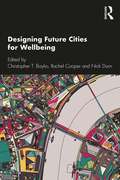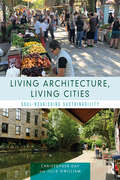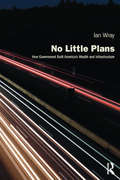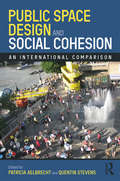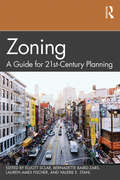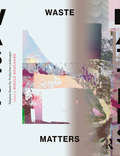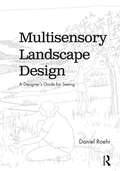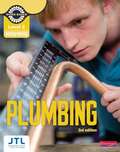- Table View
- List View
Understanding Metropolitan Landscapes
by Andrew MacKenzieUnderstanding Metropolitan Landscapes considers and reflects on the fundamental relationships between metropolitan regions and their landscapes. It investigates how planning and policy help to protect, manage and enhance the landscapes that sustain our urban settlements. As global populations become more metropolitan, landscapes evolve to become increasingly dynamic and entropic; and the distinction between urban and non-urban is further fragmented and yet these spaces play an increasingly important role in sustainable development. This book opens a key critical discussion into the relational aspects of city and landscape and how each element shapes the boundaries of the other, covering topics such as material natures, governance systems, processes and policy. It presents a compendium of concepts and ideas that have emerged from landscape architecture, planning, and environmental policy and landscape management. Using a range of illustrated case studies, it provokes discussions on the major themes driving the growth of cities by exploring the underlying tensions around notions of sustainable settlement, climate change adaption, urban migration, new modes of governance and the role of landscape in policy and decision making at national, provincial and municipal levels.
Understanding Metropolitan Landscapes
by Andrew MacKenzieUnderstanding Metropolitan Landscapes considers and reflects on the fundamental relationships between metropolitan regions and their landscapes. It investigates how planning and policy help to protect, manage and enhance the landscapes that sustain our urban settlements. As global populations become more metropolitan, landscapes evolve to become increasingly dynamic and entropic; and the distinction between urban and non-urban is further fragmented and yet these spaces play an increasingly important role in sustainable development. This book opens a key critical discussion into the relational aspects of city and landscape and how each element shapes the boundaries of the other, covering topics such as material natures, governance systems, processes and policy. It presents a compendium of concepts and ideas that have emerged from landscape architecture, planning, and environmental policy and landscape management. Using a range of illustrated case studies, it provokes discussions on the major themes driving the growth of cities by exploring the underlying tensions around notions of sustainable settlement, climate change adaption, urban migration, new modes of governance and the role of landscape in policy and decision making at national, provincial and municipal levels.
Designing Future Cities for Wellbeing
by Christopher T. BoykoDesigning Future Cities for Wellbeing draws on original research that brings together dimensions of cities we know have a bearing on our health and wellbeing – including transportation, housing, energy, and foodways – and illustrates the role of design in delivering cities in the future that can enhance our health and wellbeing. It aims to demonstrate that cities are a complex interplay of these various dimensions that both shape and are shaped by existing and emerging city structures, governance, design, and planning. Explaining how to consider these interconnecting dimensions in the way in which professionals and citizens think about and design the city for future generations’ health and wellbeing, therefore, is key. The chapters draw on UK case and research examples and make comparison to international cities and examples. This book will be of great interest to researchers and students in planning, public policy, public health, and design.
Designing Future Cities for Wellbeing
by Christopher T. Boyko Rachel Cooper Nick DunnDesigning Future Cities for Wellbeing draws on original research that brings together dimensions of cities we know have a bearing on our health and wellbeing – including transportation, housing, energy, and foodways – and illustrates the role of design in delivering cities in the future that can enhance our health and wellbeing. It aims to demonstrate that cities are a complex interplay of these various dimensions that both shape and are shaped by existing and emerging city structures, governance, design, and planning. Explaining how to consider these interconnecting dimensions in the way in which professionals and citizens think about and design the city for future generations’ health and wellbeing, therefore, is key. The chapters draw on UK case and research examples and make comparison to international cities and examples. This book will be of great interest to researchers and students in planning, public policy, public health, and design.
The Routledge Handbook on Historic Urban Landscapes in the Asia-Pacific (Routledge International Handbooks)
by Kapila SilvaThe Routledge Handbook on Historic Urban Landscapes in the Asia-Pacific sheds light onto the balancing act of urban heritage management, focusing specifically on the Asia-Pacific regions in which this challenge is imminent and in need of effective solutions. Urban heritage, while being threatened amid myriad forces of global and ecological change, provides a vital social, cultural, and economic asset for regeneration and sustenance of liveability of inhabited urban areas worldwide. This six-part volume takes a critical look at the concept of Historic Urban Landscapes, the approach that UNESCO promotes to achieve holistic management of urban heritage, through the lens of issues, prospects, and experiences of urban regeneration of the selected geo-cultural context. It further discusses the difficult task that heritage managers encounter in conceptualizing, mapping, curating, and sustaining the plurality, poetics, and politics of urban heritage of the regions in question. The connective thesis that weaves the chapters in this volume together reinforces for readers that the management of urban heritage considers cities as dynamic entities, palimpsests of historical memories, collages of social diversity, territories of contested identities, and sites for sustainable liveability. Throughout this edited collection, chapters argue for recognizing the totality of the eco-cultural urban fabric, embracing change, building social cohesion, and initiating strategic socio-economic progress in the conservation of Historic Urban Landscapes. Containing thirty-seven contributions written by leading regional experts, and illustrated with over 200 black and white images and tables, this volume provides a much-needed resource on Historic Urban Landscapes for students, scholars, and researchers.
The Routledge Handbook on Historic Urban Landscapes in the Asia-Pacific (Routledge International Handbooks)
by Kapila SilvaThe Routledge Handbook on Historic Urban Landscapes in the Asia-Pacific sheds light onto the balancing act of urban heritage management, focusing specifically on the Asia-Pacific regions in which this challenge is imminent and in need of effective solutions. Urban heritage, while being threatened amid myriad forces of global and ecological change, provides a vital social, cultural, and economic asset for regeneration and sustenance of liveability of inhabited urban areas worldwide. This six-part volume takes a critical look at the concept of Historic Urban Landscapes, the approach that UNESCO promotes to achieve holistic management of urban heritage, through the lens of issues, prospects, and experiences of urban regeneration of the selected geo-cultural context. It further discusses the difficult task that heritage managers encounter in conceptualizing, mapping, curating, and sustaining the plurality, poetics, and politics of urban heritage of the regions in question. The connective thesis that weaves the chapters in this volume together reinforces for readers that the management of urban heritage considers cities as dynamic entities, palimpsests of historical memories, collages of social diversity, territories of contested identities, and sites for sustainable liveability. Throughout this edited collection, chapters argue for recognizing the totality of the eco-cultural urban fabric, embracing change, building social cohesion, and initiating strategic socio-economic progress in the conservation of Historic Urban Landscapes. Containing thirty-seven contributions written by leading regional experts, and illustrated with over 200 black and white images and tables, this volume provides a much-needed resource on Historic Urban Landscapes for students, scholars, and researchers.
Housing, Neoliberalism and the Archive: Reinterpreting the Rise and Fall of Public Housing (Explorations in Housing Studies)
by Kathleen FlanaganFrom the mid-1940s, state housing authorities in Australia built large housing estates to enable home ownership by working-class families, but the public housing system they created is now regarded as broken. Contemporary problems with the sustainability, effectiveness and reputation of the Australian public housing system are usually attributed to the influence of neoliberalism. Housing, Neoliberalism and the Archive offers a challenge to this established ‘rise and fall’ narrative of post-war housing policy. Kathleen Flanagan uses Foucauldian ‘archaeology’ to analyse archival evidence from the Australian state of Tasmania. Through this, she reveals that the difference between past and present knowledge about the value, role and purpose of public housing results from a significant discontinuity in the way we think and act in relation to housing policy. Flanagan describes the complex system of ideas and events that underpinned policy change in Tasmania while telling a story about state housing policy, neoliberalism and history that has resonance for many other places and times. In the process, she shows that the story of public housing is more complicated than the taken-for-granted neoliberal narrative and that this finding has real significance for the dilemmas in public housing policy that face us in the here and now.
Housing, Neoliberalism and the Archive: Reinterpreting the Rise and Fall of Public Housing (Explorations in Housing Studies)
by Kathleen FlanaganFrom the mid-1940s, state housing authorities in Australia built large housing estates to enable home ownership by working-class families, but the public housing system they created is now regarded as broken. Contemporary problems with the sustainability, effectiveness and reputation of the Australian public housing system are usually attributed to the influence of neoliberalism. Housing, Neoliberalism and the Archive offers a challenge to this established ‘rise and fall’ narrative of post-war housing policy. Kathleen Flanagan uses Foucauldian ‘archaeology’ to analyse archival evidence from the Australian state of Tasmania. Through this, she reveals that the difference between past and present knowledge about the value, role and purpose of public housing results from a significant discontinuity in the way we think and act in relation to housing policy. Flanagan describes the complex system of ideas and events that underpinned policy change in Tasmania while telling a story about state housing policy, neoliberalism and history that has resonance for many other places and times. In the process, she shows that the story of public housing is more complicated than the taken-for-granted neoliberal narrative and that this finding has real significance for the dilemmas in public housing policy that face us in the here and now.
Living Architecture, Living Cities: Soul-Nourishing Sustainability
by Christopher Day Julie GwilliamIt’s widely accepted that our environment is in crisis. Less widely recognized is that three quarters of environmental damage is due to cities – the places where most of us live. As this powerful new book elucidates, global sustainability is therefore directly dependent on urban design. In Living Architecture, Living Cities Christopher Day and Julie Gwilliam move beyond the current emphasis on technological change. They argue that eco-technology allows us to continue broadly as before and only defers the impending disaster. In reality, most negative environmental impacts are due to how we live and the things we buy. Such personal choices often result from dissatisfaction with our surroundings. As perceived environment has a direct effect on attitudes and motivations, improving this can achieve more sustainable lifestyles more effectively than drastic building change – with its notorious performance-gap limitations. As it’s in places that our inner feelings and material reality interact, perceived environment is place-based. Ultimately, however, as the root cause of unsustainability is attitude, real change requires moving from the current focus on buildings and technology to an emphasis on the non-material. Featuring over 400 high quality illustrations, this is essential reading for anyone who believes in the value and power of good design. Christopher Day’s philosophy will continue to inspire students with an interest in sustainable architecture, urban planning and related fields.
Living Architecture, Living Cities: Soul-Nourishing Sustainability
by Christopher Day Julie GwilliamIt’s widely accepted that our environment is in crisis. Less widely recognized is that three quarters of environmental damage is due to cities – the places where most of us live. As this powerful new book elucidates, global sustainability is therefore directly dependent on urban design. In Living Architecture, Living Cities Christopher Day and Julie Gwilliam move beyond the current emphasis on technological change. They argue that eco-technology allows us to continue broadly as before and only defers the impending disaster. In reality, most negative environmental impacts are due to how we live and the things we buy. Such personal choices often result from dissatisfaction with our surroundings. As perceived environment has a direct effect on attitudes and motivations, improving this can achieve more sustainable lifestyles more effectively than drastic building change – with its notorious performance-gap limitations. As it’s in places that our inner feelings and material reality interact, perceived environment is place-based. Ultimately, however, as the root cause of unsustainability is attitude, real change requires moving from the current focus on buildings and technology to an emphasis on the non-material. Featuring over 400 high quality illustrations, this is essential reading for anyone who believes in the value and power of good design. Christopher Day’s philosophy will continue to inspire students with an interest in sustainable architecture, urban planning and related fields.
No Little Plans: How Government Built America’s Wealth and Infrastructure (Planning, History and Environment Series)
by Ian WrayIs planning for America anathema to the pursuit of life, liberty and happiness? Is it true, as ideologues like Friedrich Von Hayek, Milton Friedman, and Ayn Rand have claimed, that planning leads to dictatorship, that the state is wholly destructive, and that prosperity is owed entirely to the workings of a free market? To answer these questions Ian Wray’s book goes in search of an America shaped by government, plans and bureaucrats, not by businesses, bankers and shareholders. He demonstrates that government plans did not damage American wealth. On the contrary, they built it, and in the most profound ways. In three parts, the book is an intellectual roller coaster. Part I takes the reader downhill, examining the rise and fall of rational planning, and looks at the converging bands of planning critics, led on the right by the Chicago School of Economics, on the left by the rise of conservation and the ‘counterculture’, and two brilliantly iconoclastic writers – Jane Jacobs and Rachel Carson. In Part II, eight case studies take us from the trans-continental railroads through the national parks, the Federal dams and hydropower schemes, the wartime arsenal of democracy, to the postwar interstate highways, planning for New York, the moon shot and the creation of the internet. These are stories of immense government achievement. Part III looks at what might lie ahead, reflecting on a huge irony: the ideology which underpins the economic and political rise of Asia (by which America now feels so threatened) echoes the pragmatic plans and actions which once secured America’s rise to globalism.
No Little Plans: How Government Built America’s Wealth and Infrastructure (Planning, History and Environment Series)
by Ian WrayIs planning for America anathema to the pursuit of life, liberty and happiness? Is it true, as ideologues like Friedrich Von Hayek, Milton Friedman, and Ayn Rand have claimed, that planning leads to dictatorship, that the state is wholly destructive, and that prosperity is owed entirely to the workings of a free market? To answer these questions Ian Wray’s book goes in search of an America shaped by government, plans and bureaucrats, not by businesses, bankers and shareholders. He demonstrates that government plans did not damage American wealth. On the contrary, they built it, and in the most profound ways. In three parts, the book is an intellectual roller coaster. Part I takes the reader downhill, examining the rise and fall of rational planning, and looks at the converging bands of planning critics, led on the right by the Chicago School of Economics, on the left by the rise of conservation and the ‘counterculture’, and two brilliantly iconoclastic writers – Jane Jacobs and Rachel Carson. In Part II, eight case studies take us from the trans-continental railroads through the national parks, the Federal dams and hydropower schemes, the wartime arsenal of democracy, to the postwar interstate highways, planning for New York, the moon shot and the creation of the internet. These are stories of immense government achievement. Part III looks at what might lie ahead, reflecting on a huge irony: the ideology which underpins the economic and political rise of Asia (by which America now feels so threatened) echoes the pragmatic plans and actions which once secured America’s rise to globalism.
Public Space Design and Social Cohesion: An International Comparison
by Patricia Aelbrecht Quentin StevensSocial cohesion is often perceived as being under threat from the increasing cultural and economic differences in contemporary cities and the increasing intensity of urban life. Public space, in its role as the main stage for social interactions between strangers, clearly plays a role in facilitating or limiting opportunities for social cohesion. But what exactly is social cohesion, how is it experienced in the public realm, and what role can the design of city spaces have in supporting or promoting it? There are significant knowledge gaps between the social sciences and design disciplines and between academia and practice, and thus a dispersed knowledge base that currently lacks nuanced insight into how urban design contributes to social integration or segregation. This book brings together scholarly knowledge at the intersection of public space design and social cohesion. It is based on original scholarly research and a depth of urban design practice, and analyses case studies from a variety of cities and cultures across the Global North and Global South. Its interdisciplinary, cross-cultural analysis will be of interest to academics, students, policymakers and practitioners engaged with a range of subject areas, including urban design, urban planning, architecture, landscape, cultural studies, human geography, social policy, sociology and anthropology. It will also have significant appeal to a wider non-academic readership, given its topical subject matter.
Public Space Design and Social Cohesion: An International Comparison
by Patricia Aelbrecht Quentin StevensSocial cohesion is often perceived as being under threat from the increasing cultural and economic differences in contemporary cities and the increasing intensity of urban life. Public space, in its role as the main stage for social interactions between strangers, clearly plays a role in facilitating or limiting opportunities for social cohesion. But what exactly is social cohesion, how is it experienced in the public realm, and what role can the design of city spaces have in supporting or promoting it? There are significant knowledge gaps between the social sciences and design disciplines and between academia and practice, and thus a dispersed knowledge base that currently lacks nuanced insight into how urban design contributes to social integration or segregation. This book brings together scholarly knowledge at the intersection of public space design and social cohesion. It is based on original scholarly research and a depth of urban design practice, and analyses case studies from a variety of cities and cultures across the Global North and Global South. Its interdisciplinary, cross-cultural analysis will be of interest to academics, students, policymakers and practitioners engaged with a range of subject areas, including urban design, urban planning, architecture, landscape, cultural studies, human geography, social policy, sociology and anthropology. It will also have significant appeal to a wider non-academic readership, given its topical subject matter.
Culture, Community, and Development (Community Development Research and Practice Series)
by Rhonda Phillips Mark A. BrennanCulture is a living thing. In social settings, it is often used to represent entire ways of life, including rules, values, and expected behavior. Varying from nation to nation, neighborhood to neighborhood and beyond, even in the smallest localities, culture is a motivating factor in the creation of social identity and serves as a basis for creating cohesion and solidarity. This book explores the intersection of culture and community as a basis for locally and regionally based development by focusing on three core bodies of literature: theory, research, and practice. The first section, theory, uncovers some of the more relevant historical arguments, as well as more contemporary examinations. Continuing, the research section sheds light on some of the key concepts, variables, and relationships present in the limited study of culture in community development. Finally, the practice section brings together research and theory into applied examples from on the ground efforts. During a time where the interest to retain the uniqueness of local life, traditions, and culture is significantly increasing in community-based development, the authors offer a global exploration of the impacts of culturally based development with comparative analysis in countries such as Korea, Ireland, and the United States. A must-read for community development planners, policymakers, students, and researchers.
Culture, Community, and Development (Community Development Research and Practice Series)
by Rhonda Phillips Mark A. BrennanCulture is a living thing. In social settings, it is often used to represent entire ways of life, including rules, values, and expected behavior. Varying from nation to nation, neighborhood to neighborhood and beyond, even in the smallest localities, culture is a motivating factor in the creation of social identity and serves as a basis for creating cohesion and solidarity. This book explores the intersection of culture and community as a basis for locally and regionally based development by focusing on three core bodies of literature: theory, research, and practice. The first section, theory, uncovers some of the more relevant historical arguments, as well as more contemporary examinations. Continuing, the research section sheds light on some of the key concepts, variables, and relationships present in the limited study of culture in community development. Finally, the practice section brings together research and theory into applied examples from on the ground efforts. During a time where the interest to retain the uniqueness of local life, traditions, and culture is significantly increasing in community-based development, the authors offer a global exploration of the impacts of culturally based development with comparative analysis in countries such as Korea, Ireland, and the United States. A must-read for community development planners, policymakers, students, and researchers.
Zoning: A Guide for 21st-Century Planning
by Elliott Sclar Bernadette Baird-Zars Lauren Ames Fisher Valerie StahlZoning is at once a key technical competency of urban planning practice and a highly politicized regulatory tool. How this contradiction between the technical and political is resolved has wide-reaching implications for urban equity and sustainability, two key concerns of urban planning. Moving beyond critiques of zoning as a regulatory hindrance to local affordability or merely the rulebook that guides urban land use, this textbook takes an institutional approach to zoning, positioning its practice within the larger political, social and economic conflicts that shape local access for diverse groups across urban space. Foregrounding the historical-institutional setting in which zoning is embedded allows planners to more deeply engage with the equity and sustainability issues related to zoning practice. By approaching zoning from a social science and planning perspective, this text engages students of urban planning, policy and design with several key questions relevant to the realities of zoning and land regulation they encounter in practice. Why has the practice of zoning evolved as it has? How do social and economic institutions shape zoning in contemporary practice? How does zoning relate to the other competencies of planning, such as housing and transport? Where and why has zoning, an act of physical land use regulation, replaced social planning? These questions, grounded in examples and cases, will prompt readers to think critically about the potential and limitations of zoning. By re-forging the important links between zoning practice and the concerns of the urban planning profession, this text provides a new framework for considering zoning in the 21st century and beyond.
Zoning: A Guide for 21st-Century Planning
by Elliott Sclar Bernadette Baird-Zars Lauren Ames Fisher Valerie StahlZoning is at once a key technical competency of urban planning practice and a highly politicized regulatory tool. How this contradiction between the technical and political is resolved has wide-reaching implications for urban equity and sustainability, two key concerns of urban planning. Moving beyond critiques of zoning as a regulatory hindrance to local affordability or merely the rulebook that guides urban land use, this textbook takes an institutional approach to zoning, positioning its practice within the larger political, social and economic conflicts that shape local access for diverse groups across urban space. Foregrounding the historical-institutional setting in which zoning is embedded allows planners to more deeply engage with the equity and sustainability issues related to zoning practice. By approaching zoning from a social science and planning perspective, this text engages students of urban planning, policy and design with several key questions relevant to the realities of zoning and land regulation they encounter in practice. Why has the practice of zoning evolved as it has? How do social and economic institutions shape zoning in contemporary practice? How does zoning relate to the other competencies of planning, such as housing and transport? Where and why has zoning, an act of physical land use regulation, replaced social planning? These questions, grounded in examples and cases, will prompt readers to think critically about the potential and limitations of zoning. By re-forging the important links between zoning practice and the concerns of the urban planning profession, this text provides a new framework for considering zoning in the 21st century and beyond.
Waste Matters: Adaptive Reuse for Productive Landscapes
by Nikole BouchardFor thousands of years humans have experimented with various methods of waste disposal—from burning and burying to simply packing up and moving in search of an unscathed environment. Habits of disposal are deeply ingrained in our daily lives, so casual and continual that we rarely ever stop to ponder the big-picture effects on social, spatial and ecological orders. Rethinking the ways in which we produce, collect, discard and reuse our waste, whether it’s materials, spaces or places, is essential to ensure a more feasible future. Waste Matters: Adaptive Reuse for Productive Landscapes presents a series of historical and contemporary design ideas that reimagine a range of repurposed materials at diverse scales and in various contexts by exploring methods of hacking, disassembly, reassembly, recycling, adaptive reuse and preservation of the built environment. Waste Matters will inspire designers to sample and rearrange bits of artifacts from the past and present to produce culturally relevant and ecologically sensitive materials, objects, architecture and environments.
Waste Matters: Adaptive Reuse for Productive Landscapes
by Nikole BouchardFor thousands of years humans have experimented with various methods of waste disposal—from burning and burying to simply packing up and moving in search of an unscathed environment. Habits of disposal are deeply ingrained in our daily lives, so casual and continual that we rarely ever stop to ponder the big-picture effects on social, spatial and ecological orders. Rethinking the ways in which we produce, collect, discard and reuse our waste, whether it’s materials, spaces or places, is essential to ensure a more feasible future. Waste Matters: Adaptive Reuse for Productive Landscapes presents a series of historical and contemporary design ideas that reimagine a range of repurposed materials at diverse scales and in various contexts by exploring methods of hacking, disassembly, reassembly, recycling, adaptive reuse and preservation of the built environment. Waste Matters will inspire designers to sample and rearrange bits of artifacts from the past and present to produce culturally relevant and ecologically sensitive materials, objects, architecture and environments.
Multisensory Landscape Design: A Designer's Guide for Seeing
by Daniel RoehrThe interaction of our bodies in space is intrinsically linked to the ways in which we design. In spatial design we tend to focus on solely the visual, often treating it as the dominant sense while ignoring the other four senses: touch, sound, smell, taste. While research has been carried out on the perception of multisensorial experiences and design in the last two decades, there is no combined resource on how to address multisensory design in landscape architecture, architecture, urban and environmental design. This is a textbook for design students, professionals, and educators to develop multisensorial literacy. This book is the first of its kind, providing introductions on each of the five senses, along with exercises that demonstrate how to observe, record, and visualize them. It explores current design school pedagogy, and how we might imagine a more mindful way of teaching. The book is a foundational resource for students, professionals, and instructors to understand and ultimately create multisensorial spaces that are inclusive for all. This book imagines a world where seeing is redefined in a way that encompasses all of the senses—not just the visual.
Multisensory Landscape Design: A Designer's Guide for Seeing
by Daniel RoehrThe interaction of our bodies in space is intrinsically linked to the ways in which we design. In spatial design we tend to focus on solely the visual, often treating it as the dominant sense while ignoring the other four senses: touch, sound, smell, taste. While research has been carried out on the perception of multisensorial experiences and design in the last two decades, there is no combined resource on how to address multisensory design in landscape architecture, architecture, urban and environmental design. This is a textbook for design students, professionals, and educators to develop multisensorial literacy. This book is the first of its kind, providing introductions on each of the five senses, along with exercises that demonstrate how to observe, record, and visualize them. It explores current design school pedagogy, and how we might imagine a more mindful way of teaching. The book is a foundational resource for students, professionals, and instructors to understand and ultimately create multisensorial spaces that are inclusive for all. This book imagines a world where seeing is redefined in a way that encompasses all of the senses—not just the visual.
Plumbing Candidate Handbook: NVQ/SVQ Level 2 (PDF)
by Jtl TrainingTried and trusted Heinemann format breaks down theory into manageable sections, with accessible language so learners don t get bogged down.
Level 1 NVQ/SVQ Diploma Painting and Decorating (PDF)
by Kevin Jarvis Steve OlsenHeinemann's learner-focused painting and decorating resources are now available for the Level 1 NVQ/SVQ Diploma This tailor-made textbook for the Level 1 learner covers all the content from the Diploma specification and making sure candidates get the right tools for the job.
Level 2 NVQ/SVQ Diploma Painting and Decorating (PDF)
by Kevin Jarvis Steve OlsenThis handbook provides all the knowledge needed to achieve a diploma, with clear straightforward language and engaging format. Working life case studies provide real scenarios, helping candidates put their learning into context. 3rd edition.

